Using the JSON Iterator
Search form
This topic describes how to process a JSON document, which contains multiple records. A JSON document will be split into sub-documents using the JSON Iterator, and then each sub-document will be sent for further processing. This is useful whenever a request is received containing multiple records that are batched into a single JSON document. This how-to will also demonstrate how you can test the process by providing JSON as an input document. This will simulate receiving JSON as an inbound data document from any supported protocol. Note that this how-to does not implement error handling, which should be implemented in production applications.
Included With This How-To:
The following sample components should be downloaded for this how-to in the json_iterator_sample_files.zip file:
- iterator_project_json.zip – A completed application project for this how-to that you can import into iWay Integration Tools (iIT) using the Import Existing Project into Workspace option. After importing, you can browse the components and proceed to deploying the application.
- po_item10.json – A sample JSON input document that is referenced by this how-to.
________________________________________________________
Click here to download a PDF version of this How-to.
________________________________________________________
This how-to includes the following topics:
- Prerequisites
- Summary of Steps and Key Features
- Creating an Application Project
- Configuring Your Process Flow
- Adding an Iterator Object
- Adding a File Object to Write a Record to the File System
- Configuring a Loop
- Test Running Your Process Flow
Prerequisites
Before continuing, ensure that the following prerequisites are confirmed.
- Folder. The following output folder is predefined for the File listener:
C:\temp\out
Ensure that this folder created before proceeding with this how-to. However, you may also define other paths for the output folder when configuring the File listener.
- JSON File (po_item10.json). A sample JSON file containing multiple records, which is provided with this how-to.
- iWay Service Manager. A running instance of iWay Service Manager (iSM).
Summary of Steps and Key Features
This how-to consists of the following steps:
- Creating an application project.
- Creating a process flow, which will take the JSON file, iterate it through each record in the file, and then output it.
The following key features are demonstrated by this how-to:
- JSON Iterator
- File Write Object
- Process Flow Test-Run Operation
Creating an Application Project
- Open iWay Integration Tools (iIT) and select the default workspace.
- Right-click anywhere within the Application Explorer tab, select New from the context menu, and then click Application Project, as shown in the following image.
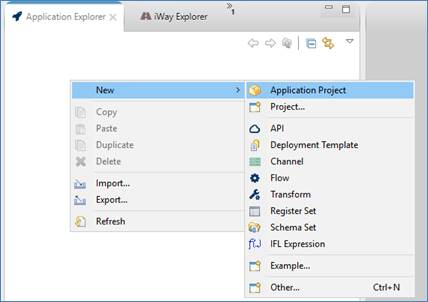
The New Application Project dialog box opens, as shown in the following image.
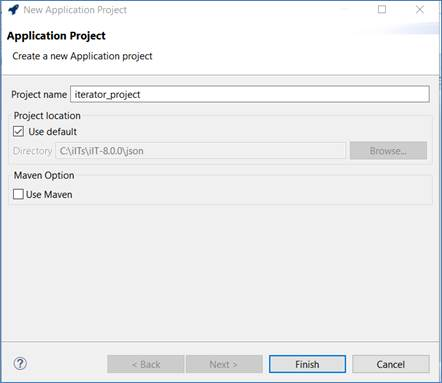
- Provide a project name (for example, iterator_project) and then click Finish.
A new application is created, containing the required project folder structure, as shown in the following image.
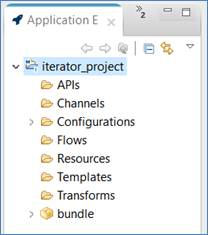
The bundle folder is the application package name, which you can rename if required. During deployment, you will be prompted to select the name of the deployed application.
You are now ready to configure your process flow.
Configuring Your Process Flow
- Right-click the Flows folder, select New and then click Flow, as shown in the following image.
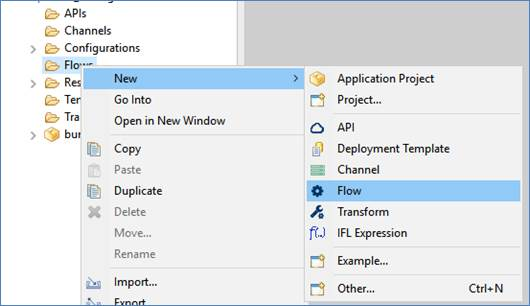
The General Properties dialog box opens, as shown in the following image.
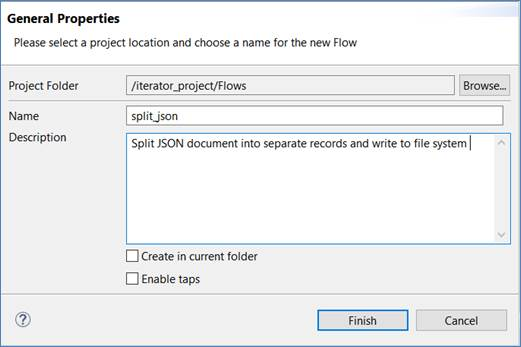
- Enter a name for your process flow (for example, split_json), a description (optional), and then click Finish.
The process flow (split_json) opens as a new tab in your workspace area where you can start building the application logic for processing data. By default, the process flow consists of a Start and an End object. You can also drag the End object to the right to give yourself more room to work with.

In this how-to, you will configure this process flow to receive a JSON input document containing multiple records. By adding an Iterator to the process flow, you will split the JSON document into many JSON sub-documents for additional processing.
Adding an Iterator Object
- From the Palette in the right pane, expand Flow Control and drag the Iterator object onto the line between the Start and End objects in your workspace area.
When the solid connector line between the objects changes to a dashed orange line, release the Iterator object, as shown in the following image.
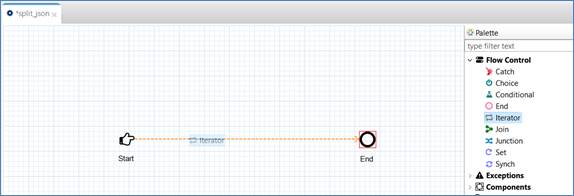
You can also drag the Iterator object onto any location in the process flow designer to be configured and then recreate the connector line relationships as required.
Once the Iterator object is added to the process flow, the corresponding configuration properties for this object are available in the Properties tab.
- From the Select Action drop-down list, select Iterate over JSON, as shown in the following image.
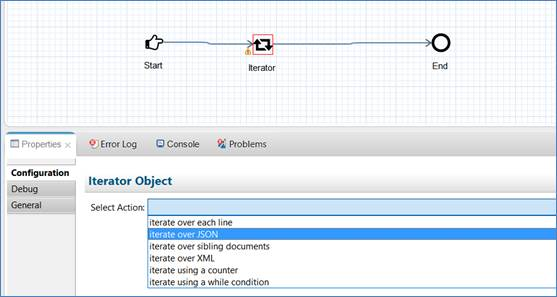
A list of configuration properties for this action is provided. The only required property is Query, which specifies what to use for parsing out the records.
-
Enter the following value in the Path Expression field:
$[*]

You are now ready to specify the next step for each record to take. This can be anything based on the application requirements, such as executing a REST call, performing further transformations, or validations, and so on. For this how-to, you will write out each record to the file system.
Adding a File Object to Write a Record to the File System
- From the Palette in the right pane, expand Connectors and drag the File object onto the line between the Iterator and End objects in your workspace area.
The File object is added to your process flow, as shown in the following image.

- From the Select Action drop-down list, select write a file, as shown in the following image.
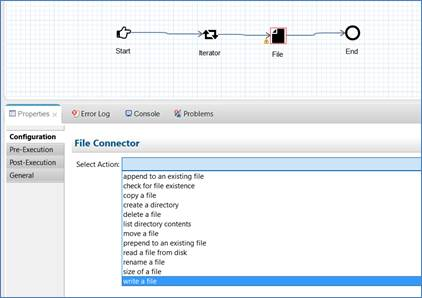
A list of configuration properties for this action is provided. The only two required parameters are for the definition of the output location and the file name to use.
- Provide the following parameter values under the Target category.
Parameter Value Directory
C:\temp\out
File Name
record_#.json
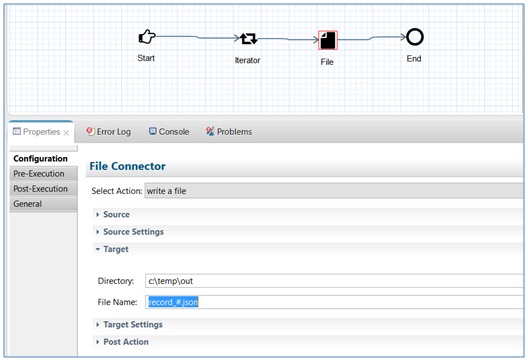
You are now ready to configure a loop from the File object, which writes single records to the file system, back to the Iterator.
Configuring a Loop
- Hover your mouse pointer over the File object.
A set of options is displayed.
- Select and drag the Create loop operation to the Iterator object.
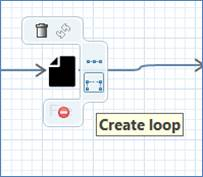
- When a dashed orange line forms on the Iterator object, release the Create loop operation.
The loop relationship will be created, as shown in the following image.

The default loop connector line is drawn to save space for complex process flows with many objects.
You can move the loop connector line accordingly for clarity or re-draw it, as shown in the following image.

- Save your work by clicking on the multi-disk icon
 which saves all the components.
which saves all the components.
You are now ready to test the process flow.
Test Running Your Process Flow
This test run will simulate receiving a JSON batch document from an external source and processing this document. In an actual application, you would associate this process flow as the route of an inbound listener or call it as an API.
- Right-click the split_json process flow under the project, select Run As, and then click Flow from the context menu, as shown in the following image.
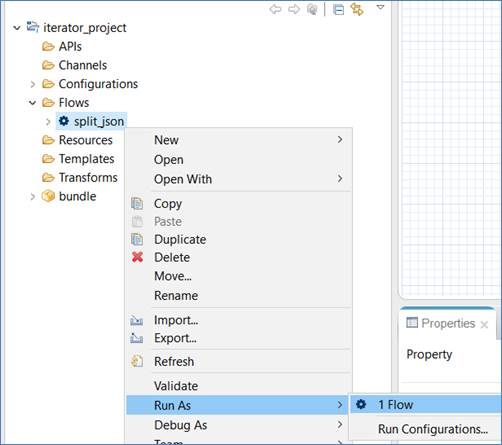
The Edit configuration dialog box opens, where you must specify values for the configuration parameters that will be used to test run the process flow.
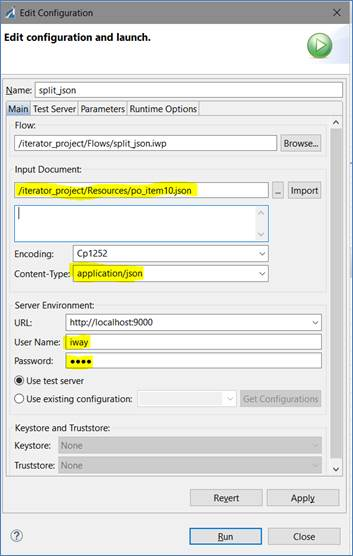
- Specify values for the parameters, as described in the following table.
Parameter Value/Action Input Document
Delete the default xml data that is displayed in the field.
Click Import, navigate to the location where the po_item10.json sample JSON document is located, and save it into the Resources folder when prompted.
Content-Type
Select application/json from the drop-down list.
User Name
iway (default user name)
Password
iway (default password)
- Click Run.
This action will create and start a test server where the process flow will be executed using the provided input document. You can also test against an existing application or provide definitions for a test server to be created.
The test run process will take about a minute, as a new server instance must be started for the test environment.
Upon successful startup, the Test run result selection dialog box opens, as shown in the following image.

Clicking the Start object in the process flow allows you to view the actual input document in the right pane.
Clicking the End object allows you to view the status response and the count of the iterators, which should be equal to 10, as shown in the following image.
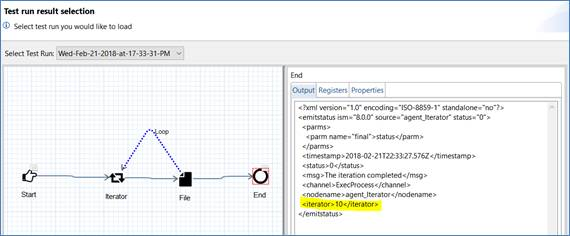
- In your file system, navigate to the following directory:
C:\temp\out
This is the location where the 10 individual records (sub-documents) from the original input JSON batch document are now written, as shown in the following image.

Notice that each file name has a counter, which was configured when record_#.json was specified as a value for the File Name parameter in the File object. The first file, which has the # indicator, is a count keeper used for internal purposes.
You can open each individual record in a text editor or JSON editor to view its data.
